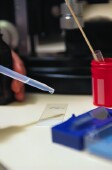
WEDNESDAY, June 30 — Researchers believe they know why Parkinson’s disease patients who received fetal cell transplants in the 1990s developed uncontrolled, involuntary movements, and they think they can prevent the troublesome side effect.
The findings could potentially make the transplant trials viable again, they said.
“These findings lend much optimism to new human trials testing the safety and efficiency of fetal or stem cell transplantation in Parkinson’s patients,” said study author Dr. Marios Politis, a clinical scientist at Imperial College London, whose report is published in the June 30 issue of Science Translational Medicine.
In the early 1990s, scientists were excited about promising results of clinical trials using fetal cell transplants to treat Parkinson’s disease.
But the excitement was short-lived. A few years later, trials were halted after patients who received the transplants began to experience dyskinesias, or uncontrolled movements.
The new research attributes the involuntary movements in two patients who received transplants in Britain in 1993 and 1996 to an excess of serotonin cells in the transplanted tissue.
Parkinson’s disease is a degenerative disorder in which the brain has a shortage of the neurotransmitter dopamine, leading to muscle rigidity, tremors and gait difficulties, and eventually cognitive trouble.
The hope for fetal cell transplants was that the tissue from midbrains of aborted fetuses could be put into Parkinson’s patients’ brains, replacing the dopamine-producing cells destroyed by the disease.
But results in human studies were unpredictable and controversial, Politis said. In the 1980s, the U.S. government banned fetal cell research, but lifted the ban in the early 1990s.
While some patients who had the transplants showed remarkable improvement — the two in the study, for example, needed no medication for Parkinson’s — not everyone improved, Politis said.
And over time, the majority of transplanted patients suffered dyskinesias, leading ethics commissions around the world to end human trials in the 1990s, he said.
In the new study, using brain imaging, Politis and his colleagues found that the dopamine neurons that decay in Parkinson’s disease were restored and functioning in the two patients. But they also found abnormal levels of serotonin neurons within the transplanted tissue.
The serotonin neurons were releasing dopamine, which, when coming from the wrong source, caused the jerking movements.
When patients were given a serotonin receptor agonist, a drug that prevented the serotonin neurons from firing, the involuntary movements ceased.
“Both patients responded by a sudden and almost complete resolution of the troublesome abnormal movements, suggesting that the excess serotonergic neurons had in fact been pumping out dopamine, causing the dyskinesias,” Politis said.
It’s possible that removing serotonin cells during the preparation of transplanted tissue in future trials will prevent side effects from developing, he added.
“We believe the first priority is to make the whole procedure more safe,” Politis said. “We need to establish patients won’t have anything worse happening to them after the surgery. And this study addresses that.”
European and North American researchers plan a new round of human trials with fetal cells in Parkinson’s disease in 2012, Politis said.
Dr. Michael S. Okun, national medical director for the National Parkinson Foundation, said the study “offers some
potentially important insights into the role of serotonin in off-medication dyskinesias that may be encountered following Parkinson’s disease fetal cell grafting.”
“The notion that a simple drug acting on the serotonin system, buspirone, proved useful in short, four-hour testing performed in two
patients is fascinating,” Okun said. “Caution, however, should be exercised in interpreting these results. No conclusion can be drawn concerning long-term treatment efficacy, and these results cannot be applied in patients who did not receive fetal cell transplants.”
The most common treatment for Parkinson’s is levodopa, which is converted into dopamine in the brain. Over time, people who take levodopa can also develop dyskinesias, but perhaps because of a different mechanism, Politis said.
Previous research has hinted at the role of serotonin in dyskinesias for other Parkinson’s patients.
More information
The National Parkinson Foundation has more on the disease.

